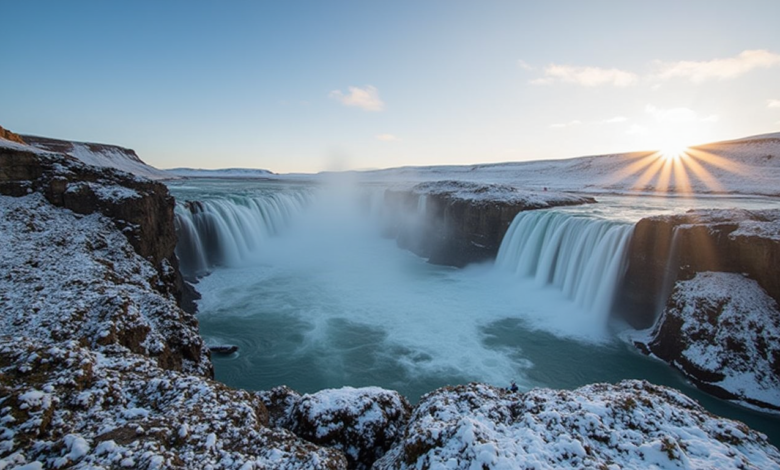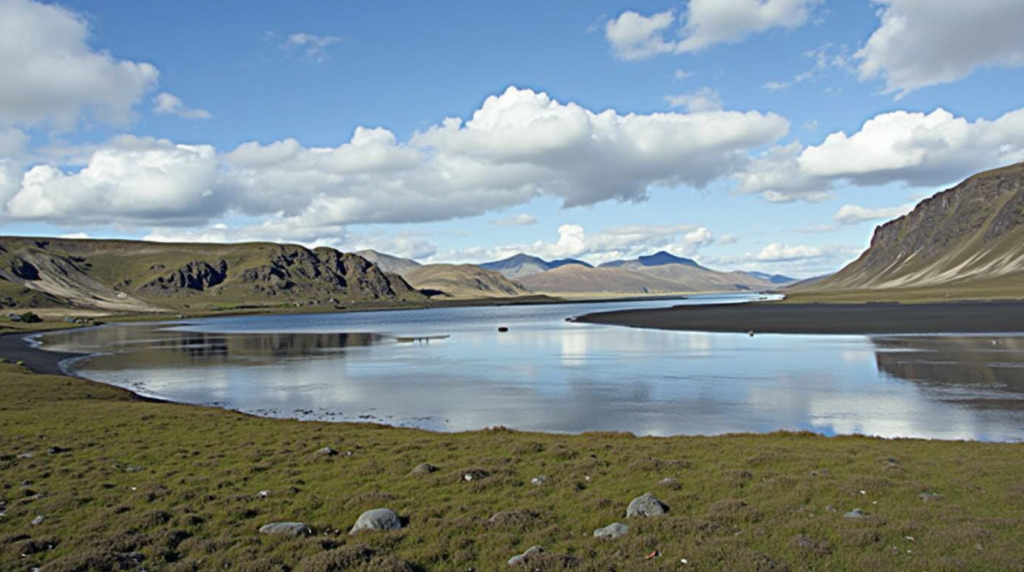Best Time to Visit Iceland in 2025

Iceland’s breathtaking landscapes, from cascading waterfalls to the mesmerizing Northern Lights, draw travelers from around the globe. But when is the best time to witness its magic? The answer isn’t as simple as you think!
The “best time” to visit Iceland depends entirely on your priorities—whether you’re chasing the midnight sun, hunting for the Northern Lights, or trying to avoid crowds while sticking to a budget. This guide breaks down everything you need to know to plan the perfect Icelandic adventure.
Table of Contents
Jump to:
- Understanding Iceland’s Seasons
- Weather in Iceland: Month-by-Month
- Best Time for Northern Lights
- Best Time for Outdoor Activities
- Budget-Friendly Times to Visit
- Avoiding the Crowds
- Essential Planning Tips
Understanding Iceland’s Seasons
Iceland’s climate creates four distinct seasons, each offering unique experiences for visitors:
Summer (June-August)
Summer brings the famous midnight sun, with nearly 24 hours of daylight in June and July. This is prime time for hiking, exploring the highlands (which are only accessible in summer), and spotting puffins along the coast. Temperatures are mild, typically ranging from 10-15°C (50-59°F).
Autumn (September-October)
As daylight hours begin to decrease, autumn offers a spectacular show of vibrant foliage across Iceland’s landscapes. This is when Northern Lights viewing begins while temperatures remain relatively moderate. You’ll also encounter fewer tourists than during the peak summer months.
Winter (November-March)
Winter transforms Iceland into a snow-covered wonderland with limited daylight—December and January may see only 4-5 hours of light per day. This is the prime season for Northern Lights hunting, exploring ice caves, and enjoying winter activities like snowmobiling on glaciers.
Spring (April-May)
Spring brings renewal to Iceland, with blooming wildflowers and returning migratory birds. Weather begins to warm, daylight hours increase significantly, and you’ll find excellent shoulder season deals before the summer rush.
Weather in Iceland: Month-by-Month Breakdown
| Month | Avg. Temp (°C) | Precipitation | Daylight Hours | Typical Conditions |
|---|---|---|---|---|
| January | -1 to 3 | High | 4-5 hours | Snow, ice, storms |
| February | -1 to 3 | High | 6-8 hours | Snow, ice, storms |
| March | 0 to 5 | Moderate | 10-12 hours | Unpredictable, snow/rain |
| April | 2 to 7 | Moderate | 13-16 hours | Changeable, rain |
| May | 5 to 10 | Low | 17-20 hours | Mild, occasional rain |
| June | 8 to 13 | Low | 20-24 hours | Mild, occasional rain |
| July | 10 to 15 | Low | 20-24 hours | Mild, occasional rain |
| August | 10 to 15 | Moderate | 16-20 hours | Mild, more rain |
| September | 7 to 12 | Moderate | 13-16 hours | Changeable, rain |
| October | 4 to 9 | High | 8-11 hours | Windy, rain, possible snow |
| November | 1 to 6 | High | 5-8 hours | Rain, snow, storms |
| December | -1 to 4 | High | 3-5 hours | Snow, ice, storms |
Monthly Summaries
January: The darkest month in Iceland offers incredible opportunities for Northern Lights viewing and unique winter activities like ice caving. Expect challenging road conditions and limited daylight.
February: Similar to January but with slightly longer days. Winter festivals begin to appear, and it’s an excellent time for winter sports enthusiasts.
March: A transitional month with increasingly longer days. The winter landscapes remain while daylight hours extend noticeably. Last chance for quality ice cave exploration.
April: Spring arrives with milder temperatures and significantly longer days. The perfect time to catch the tail end of Northern Lights season while enjoying more moderate weather.
May: A beautiful month with spring blooms and returning wildlife. Highlands remain closed, but lowland hiking trails become accessible. What month is rainy in Iceland? May typically sees less precipitation than summer and autumn months.
June: The midnight sun arrives! Endless daylight means more time for exploration. Most attractions become accessible, though some highland roads may still be closed early in the month.
July: Peak tourist season with the warmest temperatures and full midnight sun experience. All highland roads are open, and wildlife viewing is at its best.
August: Still warm with long days, though daylight begins to decrease. Excellent hiking conditions continue, and berry picking becomes popular in the countryside.
September: A magical month with fewer tourists, lovely autumn colors, and the return of the Northern Lights. Weather remains relatively mild, though rain becomes more common.
October: Autumn is in full swing with dramatic lighting for photography. Northern Lights visibility improves as nights grow longer, and fall colors peak across the landscape.
November: Winter returns with shorter days and unpredictable weather. Northern Lights viewing is excellent, and winter activities begin to open.
December: The festive season brings Christmas markets and holiday traditions. With minimal daylight, it’s perfect for Northern Lights but challenging for driving and outdoor activities.

Best Time to Visit Iceland Based on Your Interests
Seeing the Northern Lights
The Northern Lights (Aurora Borealis) are one of Iceland’s most sought-after attractions. To maximize your chances of witnessing this spectacle:
- Best months: September to April
- Prime conditions: Dark, clear skies away from light pollution
- Peak viewing hours: 9 PM to 2 AM
- Top locations: Thingvellir National Park, Lake Myvatn, Jokulsarlon Glacier Lagoon
For the best experience, check the aurora forecast on the Icelandic Meteorological Office website before heading out. Consider booking a guided Northern Lights tour for expert knowledge and transportation to optimal viewing locations.
Hiking and Outdoor Activities
Iceland’s dramatic landscapes are a hiker’s paradise, but timing is crucial:
- Best months for general hiking: June to September
- Highland access: Mid-July to early September
- Popular trails: Laugavegur Trail, Fimmvörðuháls, Hornstrandir Nature Reserve
During shoulder seasons (May and October), many lowland trails remain accessible with fewer crowds, though weather can be unpredictable. Winter hiking requires specialized equipment and often a guide.
Whale Watching
Iceland’s waters host over 20 whale species throughout the year:
- Peak season: May to September
- Species: Minke whales, humpbacks, blue whales, orcas
- Top locations: Húsavík (the whale watching capital), Reykjavik, Akureyri
For orca sightings specifically, winter months (December to March) around the Snæfellsnes Peninsula offer the best opportunities.
Puffin Watching
These charming seabirds are seasonal visitors to Iceland:
- Season: Mid-May to mid-August
- Best locations: Westman Islands, Látrabjarg cliffs, Borgarfjörður Eystri
July provides the best opportunity to see puffins with their chicks before they head back to sea in August.
Ice Caving
Natural ice caves form in Iceland’s glaciers during winter:
- Season: November to March
- Important note: Always visit with a certified guide
- Popular locations: Vatnajökull glacier, Langjökull glacier
Each ice cave is unique and may change or disappear from year to year, making each visit a truly exclusive experience.
Festivals and Events
- Winter Lights Festival, Reykjavik: February
- Aldrei fór ég suður Music Festival: Easter weekend
- Secret Solstice Festival: June
- Iceland Airwaves: November
- Þorrablót (Traditional Midwinter Festival): January
Best Time to Visit Iceland Based on Budget
Is Iceland expensive to visit? Yes, Iceland ranks among Europe’s pricier destinations, but strategic timing can make a significant difference to your budget.
Shoulder Seasons (April-May & September-October)
These months offer the perfect balance between experience and cost:
- Accommodation prices drop 20-30% compared to summer
- Car rental rates decrease by 15-25%
- Fewer tourists mean better deals on tours
- Most attractions remain accessible
- Weather is still reasonably favorable
Off-Season (November-March, excluding Christmas/New Year)
The most budget-friendly time to visit:
- Accommodation rates can be 40-50% lower than peak season
- Flight prices often drop significantly
- Many tours offer winter discounts
- Northern Lights viewing without premium summer prices
Tips for Saving Money in Iceland
- Book accommodations with kitchen facilities to save on restaurant meals
- Bring a reusable water bottle (Iceland’s tap water is excellent)
- Take advantage of happy hours at Reykjavik bars and restaurants
- Use public transportation in Reykjavik instead of taxis
- Shop at budget supermarkets like Bonus or Kronan
- Consider camping in summer (but book campsites in advance)
- Visit natural attractions which are typically free, rather than paid experiences
Crowds and Popularity
Peak Season (June-August)
During summer months, Iceland experiences its highest tourist numbers:
- Popular attractions like the Golden Circle and Blue Lagoon can be crowded
- Accommodation in Reykjavik and along the South Coast books up months in advance
- Prices for everything from tours to restaurants increase
- Traffic on the Ring Road increases significantly
Avoiding the Crowds
- Visit popular sites early morning or evening (possible due to extended daylight in summer)
- Consider the less-visited regions like the Westfjords or East Iceland
- Travel during shoulder seasons for a balance of good weather and fewer tourists
- Book accommodations and rental cars well in advance regardless of when you visit
Planning Your Trip: Essential Tips
What to Pack
Year-round essentials:
- Waterproof jacket and pants
- Hiking boots with good traction
- Layers (thermal underwear, fleece, wool sweater)
- Swimwear (for hot springs and pools)
- Hat, gloves, and scarf (even in summer)
Summer additions:
- Eye mask for sleeping during midnight sun
- Lighter layers for warmer days
- Insect repellent (especially for Lake Myvatn area)
Winter additions:
- Heavy-duty winter coat
- Insulated waterproof boots
- Crampons for icy conditions
- Extra layers of thermal clothing
- Hand/foot warmers
Getting Around
Rental car: Offers the most flexibility but requires confidence driving in varying conditions. In winter, 4×4 vehicles are highly recommended.
Public buses: Connect major towns but have limited schedules, especially in winter.
Guided tours: Excellent option for specific activities and in winter when driving can be challenging.
Domestic flights: Save time when traveling between distant regions like Reykjavik and Akureyri.
Accommodation Options
- Hotels: Comfortable but expensive, especially in Reykjavik and during summer
- Guesthouses: More affordable with a local touch
- Hostels: Budget-friendly with social atmosphere
- Farm stays: Unique rural experience with potential for northern lights viewing
- Camping: Most economical option during summer months (May-September)
Safety Considerations
- Weather changes rapidly: Always check road conditions at road.is
- Inform someone of your plans: Use the SafeTravel.is website
- Respect nature: Stay on marked paths and never approach ocean waves
- Wind damage to car doors: Always hold doors firmly when opening in windy conditions
- Geothermal areas: Stay on marked paths to avoid burns from hot springs
Conclusion
The best time to visit Iceland truly depends on what you hope to experience. Summer offers endless daylight and accessible highlands, while winter brings magical Northern Lights and ice caves. Shoulder seasons provide an excellent balance of reasonable weather, fewer crowds, and better prices.
Whenever you choose to visit Iceland, proper preparation will ensure an unforgettable experience in this land of fire and ice. From the geothermal wonders of the Golden Circle to the dramatic black sand beaches of Vik, Iceland’s landscapes never disappoint—regardless of the season.
What are you most looking forward to experiencing in Iceland? Will you chase the midnight sun or hunt for the dancing Northern Lights? Share your plans in the comments below!



